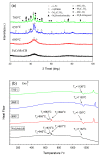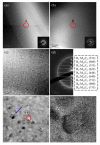The Effect of Heat Treatment on the Corrosion Resistance of Fe-Based Amorphous Alloy Coating Prepared by High Velocity Oxygen Fuel Method
- PMID: 34947412
- PMCID: PMC8708051
- DOI: 10.3390/ma14247818
The Effect of Heat Treatment on the Corrosion Resistance of Fe-Based Amorphous Alloy Coating Prepared by High Velocity Oxygen Fuel Method
Abstract
In this study, Fe40Cr19Mo18C15B8 amorphous coatings were prepared using high velocity oxygen fuel (HVOF) technology. Different temperatures were used in the heat treatment (600 °C, 650 °C, and 700 °C) and the annealed coatings were analyzed by DSC, SEM, TEM, and XRD. XRD and DSC results showed that the coating started to form a crystalline structure after annealing at 650 °C. From the SEM observation, it can be found that when the annealing temperature of the Fe-based amorphous alloy coating reached 700 °C, the surface morphology of the coating became relatively flat. TEM observation showed that when the annealing temperature of the Fe-based amorphous alloy coating was 700 °C, crystal grains in the coating recrystallized with a grain size of 5-20 nm. SAED analysis showed that the precipitated carbide phase was M23C6 phase with different crystal orientations (M = Fe, Cr, Mo). Finally, the corrosion polarization curve showed that the corrosion current density of the coating after annealing only increased by 9.13 μA/cm2, which indicated that the coating after annealing treatment still had excellent corrosion resistance. It also proved that the Fe-based amorphous alloy coating can be used in high-temperature environments. XPS analysis showed that after annealing FeO and Fe2O3 oxide components increased, and the formation of a large number of crystals in the coating resulted in a decrease in corrosion resistance.
Keywords: HVOF; amorphous structure; corrosion; heat treatment.
Conflict of interest statement
The authors declare no conflict of interest.
Figures







References
-
- Lin T.J., Sheu H.H., Lee C.Y., Lee H.B. The study of mechanical properties and corrosion behavior of the Fe-based amorphous alloy coatings using high velocity oxygen fuel spraying. J. Alloys Compd. 2021;867:159132. doi: 10.1016/j.jallcom.2021.159132. - DOI
-
- Si C., Duana B., Zhang Q., Cai J., Wu W. Microstructure, corrosion-resistance, and wear-resistance properties of subsonic flame sprayed amorphous Fe–Mo–Cr–Co coating with extremely high amorphous rate. J. Mater. Res. Technol. 2020;9:3292–3303. doi: 10.1016/j.jmrt.2020.01.024. - DOI
-
- Shi L., Qin X., Yao K. Tailoring soft magnetic properties of Fe-based amorphous alloys through C addition. Prog. Nat. Sci. Mater. Int. 2020;30:208–212. doi: 10.1016/j.pnsc.2020.02.001. - DOI
-
- Zhou Y.K., Liu X.B., Kang J.J., Yue W., Qin W.B., Ma G., Fu Z.Q., Zhu L.N., She D.S., Wang H.D., et al. Corrosion behavior of HVOF sprayed WC-10Co4Cr coatings in the simulated seawater drilling fluid under the high pressure. Eng. Fail. Anal. 2020;109:104338. doi: 10.1016/j.engfailanal.2019.104338. - DOI
-
- Farmer J., Choi J.S., Saw C., Haslam J., Day D., Hailey P., Lian T., Rebak R., Perepezko J., Payer J., et al. Iron-Based Amorphous Metals: High-Performance Corrosion-Resistant Material Development. Metall. Mater. Trans. A. 2009;40:1289–1305. doi: 10.1007/s11661-008-9779-8. - DOI
Grants and funding
LinkOut - more resources
Full Text Sources

